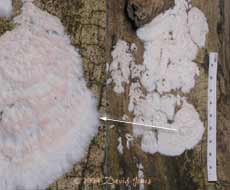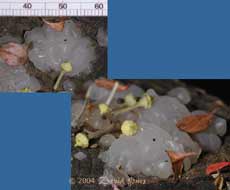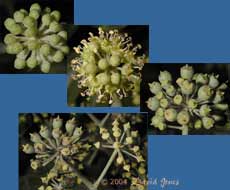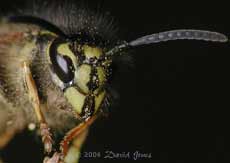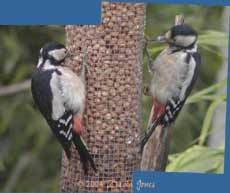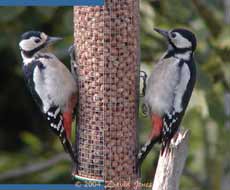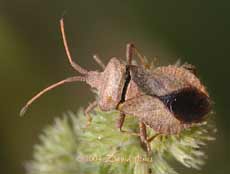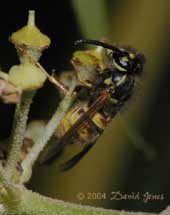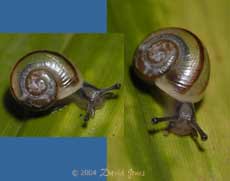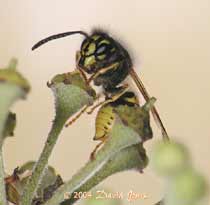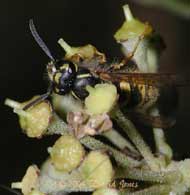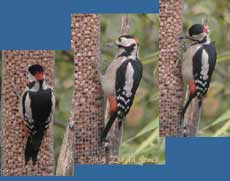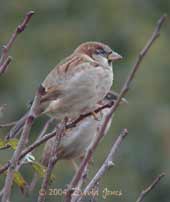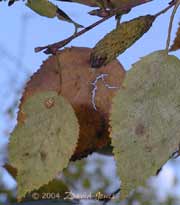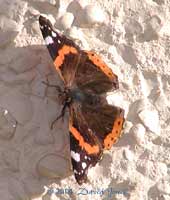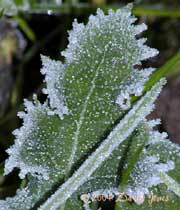Go to latest entry on this page....... ...........Go to previous entry1 November - If the first day of November is anything to go by, roll on Spring! Today it has remained dry, but we have been stuck under a uniformly dull, grey blanket of cloud. Light levels have remained low and there have been very few insects evident around the garden.
In the right-hand images you can see where the growth has appeared around holes that I drilled into the wood. I can't remember what tree the wood is from.
Other areas of the log have a very different growth on them. This is gelatinous in appearance and also feels jelly-like to the touch. Thanks to Malcolm Storey for identifying
this - 'The jelly fungus is Exidia thuretania - the white spots
inside are said to be calcium oxalate'. Malcolm, and Matt Smith (both
contributors on the Yahoo British insects newsgroup) also confirm that the
Orange flies I was photographing over the last few days are dung flies (Scathophaga
species). You'll notice in the second image that flower heads from the Ivy have fallen onto the log. There is a scattering of them all over the ground now. They are flowers that were not pollinated (or fertilised) successfully.
Quite a few of the flowers have now gone on to produce fruit (right image) which will contain up to five seeds. The lower image shows two adjacent umbels, where the left one is well on its way to producing berries while the right hand one has failed completely. That one is typical of those that are falling from the Ivy at the moment. It seem strange that whole umbels should fail like this. I would expect the failures to be more random, as in the left hand umbel where there are both fertilised and unfertilised flowers. Are some umbels simply infertile?
It is obvious in (the large version of) this picture that the the hairy face of the wasp is ideal for collecting a dusting of pollen and transferring it to stigmas as the wasp feeds on the nectar secreting discs on each flower. Two days ago I mentioned seeing Goldcrests for the first time for ages. What I forgot to mention was that after they disappeared I spent some time watching, and listening to a Dunnock as it displayed furiously up in the conifers. I assume this was a territorial display as a second bird, some yards away seemed to be replying with equal vigour. Today, there was a male Blackbird in the Hawthorn - I wonder if it was the one I photographed two days ago. I put some raisins under the tree, and although I didn't see it on the ground today I am keeping my fingers crossed that we will attract it back into the garden. I have really missed seeing them here.
2 November - A second very glum day, with added dampness this time!
The right hand image, taken first, shows her holding her left foot in a way that suggests that it may be damaged. Unfortunately, when she returned about twenty minutes later she kept her other side to me so I couldn't see that foot.
As a matter of technical interest, the two photographs were taken from my bedroom, the right hand one through the double glazing, and through an open window for the left hand image - there was a definite improvement. Both images are 'grainy' as I had set the camera to the highest ASA setting (400) to cope with the poor light. This afternoon we spent some time in Guildford as I visited a couple of camera shops to try out DSLR cameras/lenses - The Olympus 2100UZ has served me well in the garden, but it may become my backup camera in the near future. 3 November - The grey has gone, and we are having a pleasant sunny first half of the day. The woodpecker returned and I took advantage of the improved lighting to get some better pictures through an open bedroom window (but still a bit 'grainy' because I forgot to switch the camera from 200ASA back to its 100ASA setting!). I watched it for quite a while, and at no time did she attempt to use her left foot, using her tail to counter the tendency to twist anticlockwise as she fed. How much will an injury like this be a hindrance when it comes to pairing and mating next Spring? The feeder is around 45ft away from my camera position in the bedroom and these images are heavily cropped, but I am going to resist moving the feeder any closer to the house for the foreseeable future.
The sunshine is also encouraging insects to appear, including this squash bug. It was perched on the seedhead of a mint plant next to the big pond, leaving just after this picture was taken. I thought it was a Coreus marginatus, but a close look at the picture causes me a bit of doubt. This has only one small horn at the front of the head between the antennae, while C. marginatus has two. It also seems to have slightly more rounded 'shoulders' on its thorax. Click on images to see larger versions
4 November - A dry day after a heavy shower in the early morning. When I checked the Ivy during the early afternoon there were fewer insects about, with the small numbers of Drone Flies being more numerous than the wasps that were visiting.
Tonight, with dew forming, I could see no activity on the plant, although I did spot this solitary Common Wasp that is roosting in a quite exposed spot low down on the Ivy. It didn't flinch as I took several photographs.
On one of the bamboo plants the only active animals that I found with my torch were a couple of tiny snails. This one's shell measures about 6-8mm across.
Active in a much more vigorous way are the two hedgehogs that have eluded my camera lens tonight. There was a large adult and a very small individual which was also here last night.
By 9am the wasp pictured last night was awake but, despite the hazy sunshine in the East, it didn't appear ready to start the day yet!
At the end of the day it (or another wasp) was there again, fast asleep at 10.15pm.
7 November - I'm afraid that I missed the fireworks last night - it was damp outside, so I didn't risk taking my camera outside. Today it is an overcast and damp day again and the camera is staying indoors. However, despite the conditions there are a few sightings to record. First of all, yesterday I saw the Goldcrests again. A pair of them were dashing around the Birch tree (so I can really claim them this time!) before returning to the conifers where I watch them for some time as they searched for food amongst the branches. Here in the garden the two Goldfinches seem to have become regulars now, and one is feeding as I write this. Also, the male Blackbird continues to visit, although I have yet to see him feed here.
It was much more 'sprightly' in its movements than was the female, and did not appreciate sparrows that tried to share the feeder with it, making threatening gestures towards any that landed.
8 November - Another dull, overcast day! Today's Telegraph newspaper carries a gloomy report about the prospects of many European birds, including 'urban' species like our House Sparrows. I'm glad to report that our flock seems to be maintaining itself, dashing about between the cover in our garden and the shrubs and small trees in other gardens in the neighbourhood. I watched them for a while this morning, as a male Sparrowhawk attempted to snatch one from the Hawthorn. As is the case in most attacks, it left without success. While many of the flock concentrate on hustling for a spot on a feeder, there are always a few, like this pair, that seem to act as lookouts at the top of the tree. Their noisy reaction to the hawk's approach causes the whole flock to dive into the centre of the tree where they are well protected from the predator.
13 November - A bright and sunny day, and the first 'ice on the birdbath' morning. The last few days have seen a mixture of bright and gloomy periods. I have been doing very little in the way of photography, or anything else as the CFS has been a bit of a pain. On a positive note, my new camera (a Canon 20D) and various bits and pieces are on order from my friendly local dealer and I hope to get my hands on it in the near future.
There is very little activity on the Ivy now, even though there are still flowers in the early stages of flowering. At lunchtime today I could see just two Bluebottles, despite the sunshine. On the Birch the Orange Ladybirds continue to graze on the mildew that grows on the yellowing leaves. Although there is just one in this picture, taken two days ago, I can still count at least a dozen on the lower leaves.
I haven't seen the Woodpeckers here since
the 7th, which is disappointing. The Goldfinches continue to feed (usually
just one, sometimes two) and we have had several visits from a small flock
of Starlings. There are Blue Tits about most of the time at the moment and I
have seen a couple of Great Tits coming to the peanuts.
The sunshine has brought out this Red Admiral which, as I write this at 1.45pm, is 'sunbathing' on our veranda. I had hoped to see more of these visitors while the Ivy flowering was at its peak.
This evening I've had a very pleasant surprise. My sister telephoned to ask which TV channel I had been watching, as mybitoftheplanet had been featured on a program called 'Click on Line' on the BBC News 24 channel - and I missed it! The program will be repeated tomorrow so I will get a chance to see it then (if I remember!).
It seems that the birds are getting into winter mode now. There was the welcome sight of a female blackbird rooting around amongst the fallen leaves under the Birch and by the side of the pond, and a Robin foraged under the Hawthorn.
This morning I found the item about the site on the BBC clickonline website (you will need to select the programme for 13 November 2004)- thank you, webscape presenter Kate Russell for your kind comments about mybitoftheplanet, they are very much appreciated. Click on images to see larger versions |
|
